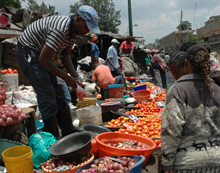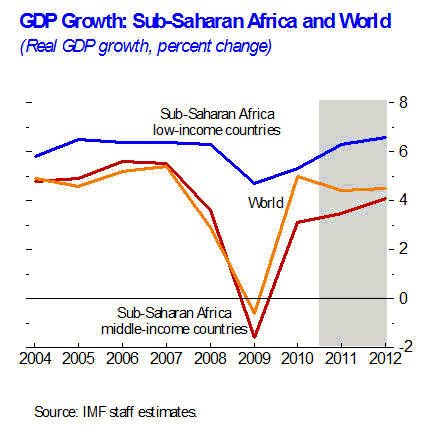
Typical street scene in Santa Ana, El Salvador. (Photo: iStock)
IMF Survey: Sub-Saharan Africa's Recovery Maintains Momentum
January 25, 2011
- Most sub-Saharan African countries have regained pre-crisis growth rates
- Domestic demand, growing ties with Asia set to sustain strong performance
- But rising world food prices may hit budgets of urban poor
In its World Economic Outlook Update, the IMF said most countries in sub-Saharan Africa have recovered quickly from the global financial crisis, with the region projected to grow 5½ percent in 2011.

Street market in Nairobi, Kenya: Africa’s urban poor vulnerable to rising food prices due to food’s big share in their consumption baskets (IMF photo)
WORLD ECONOMIC OUTLOOK
Low income countries, which escaped the worst impacts of the global crisis, are expected to match pre-crisis growth rates of about 6½ percent in 2011. But the recovery in South Africa has been more subdued, restricting projected growth to about 3½ percent in 2011.
Domestic demand in most countries is being supported by automatic stabilizers, expansion in public investment and social support programs, and continued monetary accommodation. Growing trade ties with Asia are also playing a role in the region’s recovery, primarily through commodity markets.
One major concern raised in the World Economic Outlook Update is that rising global fuel and food prices may have a significant impact on Africa in 2011. While the effects of recent increases in world food prices have so far been small in Africa, because of good local harvests, the urban poor remain very vulnerable to rising food prices because of the high share of food in their consumption baskets. This may increase pressure for additional support from government budgets.
Managing such spending pressures, particularly against the backdrop of elevated fiscal deficits and narrowing output gaps, will be an important challenge for the region in 2011—a year with a busy political calendar, including perhaps 17 national elections.
Resilience and recovery
Prior to the recent global crisis, sub-Saharan Africa enjoyed a period of strong growth. Growth in the region’s 29 low-income countries was particularly impressive at more than 6 percent during 2004–08, second only to developing Asia. This reflected the improved political environment, favorable external conditions, and sound macroeconomic management.
These strong initial conditions helped most countries in the region weather the worst effects of the food and fuel price hikes of 2007–08 and the subsequent global financial crisis. Many countries supported output by injecting fiscal stimulus and lowering interest rates. As a result, low-income countries in the region continued to grow at nearly 5 percent in 2009 (see chart).

In several of the region’s middle-income countries, however, including South Africa, output fell in 2009, while most oil-exporting countries—with the notable exception of Nigeria—experienced a significant slowdown.
As in the crisis period, the global recovery has seen substantial variations in country growth rates. While output growth in most oil exporters and low-income countries is now close to pre-crisis rates, South Africa and its neighbors continue to lag behind.
Policy outlook
With recovery well under way in most countries in the region, but global risks to growth still weighted to the downside, the report notes that the emphasis of macroeconomic policies needs to shift. Among the major risks that need to be taken into account is the still modest and uncertain pace of recovery in Europe, which remains the dominant trade partner for most non-oil-exporting countries in sub-Saharan Africa.
The report concludes:
• Countercyclical fiscal policy during the crisis resulted in wider fiscal deficits across the board. As growth in most countries approaches potential, the consistency of these wider deficits with financing and medium-term debt sustainability considerations should be reviewed. To promote growth and poverty reduction, increased attention also needs to be given to the composition of government spending and revenue sources.
• Inflation remains in check in most countries, and the monetary stance seems appropriate. But policymakers should remain alert to potential pressure from rising commodity prices and narrowing output gaps.
• Other policy areas requiring sustained attention include more intensive monitoring and sounder regulation of the financial sector, continuing policy improvements targeted at the business environment, and robust public financing mechanisms to plan and control government spending, including infrastructure investment.


